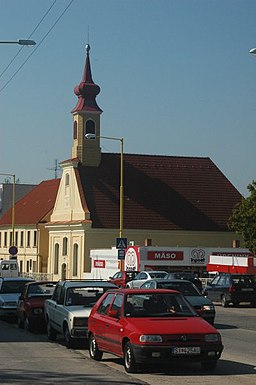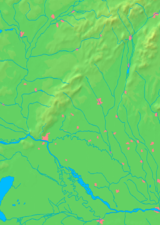Holitsch
| Holíč | |
| Town | |
|
A Lutheran church in Holíč
|
|
| Country | Slovakia |
|---|---|
| Region | Trnava |
| District | Skalica |
| River | Morava |
| Elevation | 185 m (607 ft) |
| Coordinates | 48°48′44″N 17°09′38″E / 48.81222°N 17.16056°ECoordinates: 48°48′44″N 17°09′38″E / 48.81222°N 17.16056°E |
| Area | 34.787 km2 (13.431 sq mi) |
| Population | 11,627 (31 December 2005) |
| Density | 334/km2 (865/sq mi) |
| First mentioned | 1208 |
| Mayor | Zdenko Čambal |
| Timezone | CET (UTC+1) |
| - summer (DST) | CEST (UTC+2) |
| Postal code | 908 51 |
| Phone prefix | 421-34 |
| Car plate | SI |
| Statistics: MOŠ/MIS | |
| Website: http://www.holic.sk | |
Holíč (until 1946 "Holič", German: Weißkirchen (an der March) / Holitsch, Hungarian: Holics) is a town in western Slovakia.
The oldest archaeological findings are from the Neolithic, and there are findings from the Bronze Age, Iron Age and the Roman time. The town was first mentioned in 1205 as Wywar, meaning "New Castle". The Árpád dynasty built a stone castle after Mongol invasion in 1241. Holíč was in the 13th century until 1296 seat of a border comitatus. Among the owners of the town were Matthias Csák and Stibor of Stiborice. In the 15th century the town's development was slowed by the Hussite raids. In 1736 the town was bought by Franz I, Holy Roman Emperor, husband of Maria Theresa and manufactures were built, leading to the town's growth. Maria Theresa also rebuilt the Holíč Castle from a fortress into a summer château of the Habsburgs. Holíč's once thriving Jewish community was completely decimated by the Holocaust.
The name Holíč (also spelled Holitsch) also refers to a type of tin-glazed earthenware faience that was manufactured in the area. The Holitsch factory (Slovakia) was founded in 1743 by Francis of Lorain consort of Empress Maria Teresia. The factory concentrated on the production of richly adorned sets intended to emulate the wares used by the aristocracy in the large western European centers. The factory, which served as a revitalizing force against the decline of local potters in the 18th century, brought together experts from different countries in a co-operative effort to produce wares from which later central European factories derived their inspiration. Responding to an eager market and following patterns established at the Strasbourg factory, the Holitsch factory produced remarkably life like pieces imitating fruits and vegetables. These fine examples of modeling were further distinguished by the brightness of the colors used in their decorations. The potters also created sculpture vessels of human or animal shapes that were intended for a practical as well as decorative use such as salt dishes, parrot bottles and lidded containers.
...
Wikipedia





